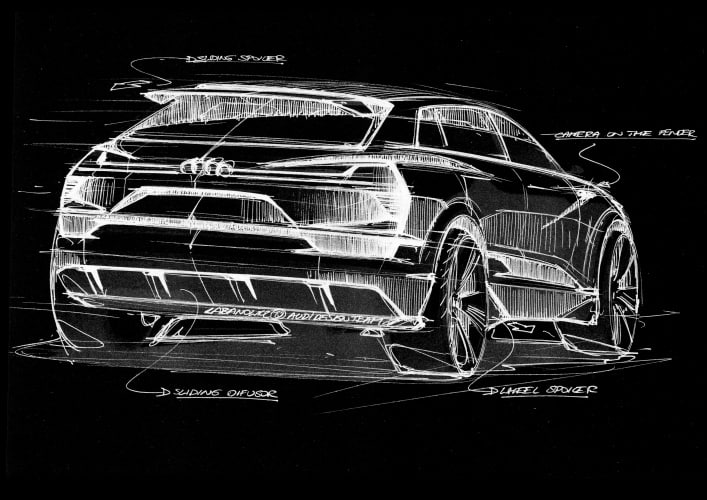Previewed by the Audi e-tron quattro concept due to debut at next month’s Frankfurt motor show, it will be the first large-scale production electric vehicle (EV) to come from the German brand.
Three electric motors – one on the front axle and two on the rear – will be used to provide four-wheel drive, while a large lithium ion battery back will be positioned low between the axles to aid weight distribution.
The R8 e-tron’s charging system has been engineering to accept fast charging at up to 150W
Audi says the car has been designed from the ground up as an EV. The concept features movable aerodynamic elements on the front, the sides and the rear to control the airflow – presumably to balance cooling requirements with drag. It also uses a completely flat underfloor, helping to reduce the coefficient of drag to just 0.25, setting a new record for the SUV segment.
The e-tron SUV’s battery will use cells from South Korean manufacturers LG Chem and Samsung SDI. Both firms are investing heavily in new cell technology and are expected to supply Audi from their European plants.
Structurally, the car will be based on the Volkswagen Audi Group’s second generation MLB platform, which is also expected to underpin the Bentley Bentayga and the next Porsche Cayenne. Using a selection of modular components built from aluminium and ultra-high strength steel, it can be stretched and shaped to fit just about any longitudinally front-engined design.
Size-wise the new car will fit between the Q5 and the Q7. This, allied to the current trend for using even numbers for the more sporting models, suggests the coupe-like SUV will be badged the Q6 e-tron. Audi board member Ulrich Hackenberg said that the aim was to provide “an attractive overall blend of sportiness and range”, and the straight line performance is expected to compare well with internal combustion models.

The all-electric e-tron quattro will follow on from Audi’s existing plug-in hybrid models, including the C-segment A3 Sportback e-tron and the forthcoming Q7 e-tron SUV. Although it will be the first mainstream model from the brand to rely solely on electric power, it won’t be alone. The long-awaited R8 e-tron sports car is due to go into production at the end of this year.
It’s likely the technology used on the Q6 will take its lead from the R8 e-tron, which uses no less than 7,488 individual cells packed into a T-shaped battery weighing around 595kg. It boasts 90.2 kWh and a power density of 152Wh/kg. Perhaps more importantly, the R8 e-tron’s charging system has been engineering to accept fast charging at up to 150kW – theoretically enough to provide 90 miles’ range in just 15 minutes.
The biggest challenge to the Q6 is likely to come externally, however. Californian manufacturer Tesla has stolen the march on its European rivals in the EV market and it’s due to release its own SUV, the Model X, later this year.
Author: Chris Pickering





Swiss geoengineering start-up targets methane removal
No mention whatsoever about the effect of increased methane levels/iron chloride in the ocean on the pH and chemical properties of the ocean - are we...